
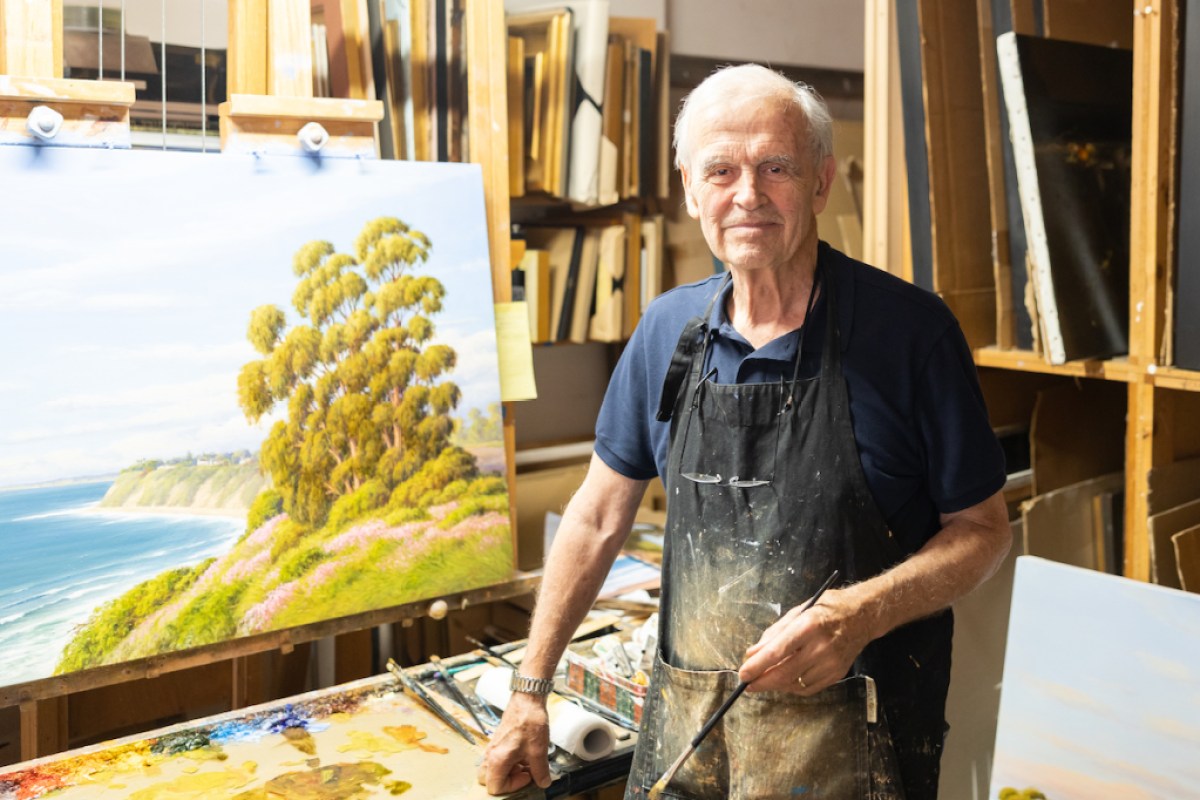
Happy birthday, Ralph Waterhouse. Today, October 12, marks this iconic Santa Barbara artist’s 80th year on this earth. He’s also celebrating other milestones, including 50 years of making a living as a painter. The famous gallery in Downtown Santa Barbara’s La Arcada that carries his last name, co-owned by his wife and muse, Diane, is similarly commemorating 39 years this November, so there’s quite a lot to celebrate.
Ralph continues painting to this day, as well as promoting and mentoring other artists. As a sign that he’s not slowing down any time soon, the couple has just recently opened a second Waterhouse Gallery on Coast Village Road in Montecito. Reflecting on his longevity in the art business, Ralph says, “It gives me a lot of satisfaction. I enjoy the creative process very much. I never feel like I’m going to work. I like being around other painters. I like to look at the different styles. It’s also fulfilling to champion other artists and their work. It’s nice to have a nurturing place.”
“Ralph has always been and will always be one of my all-time favorite painters,” says Derek Harrison, an artist represented by the Waterhouse Gallery. “There is nobody who paints eucalyptus trees like Ralph. He captures all of the beauty Santa Barbara has to offer so eloquently and distinctly.”
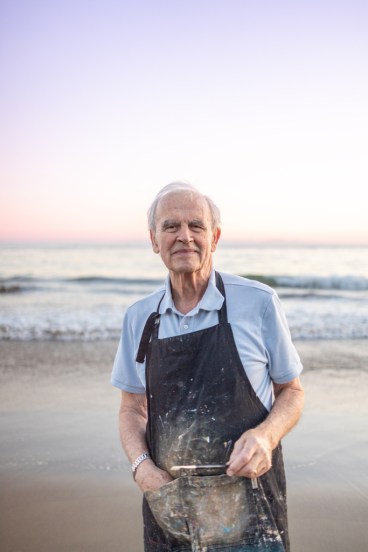
Although he started his career and became internationally recognized as a wildlife painter, Ralph turned to landscapes in the late 1980s. This trajectory from intimate and highly detailed work to a much more expansive canvas enshrining California vistas paralleled his own journey from his native England to his current home in Santa Barbara. His work is at once truthful and poetic, delicately balancing values and colors. He encourages the viewer to go past its transcendent beauty into a much richer understanding of and respect for our surroundings.
“Ten percent of my painting is done plein air,” Ralph explains. “I work from photographs that I take, capturing a moment as I walk. Quite a few paintings are not of a real place but of a place I’d like to be, but always based on something real. Somewhere where I’ve been, but with a light I wished it’d been at. I change the mood. I change the time of day. I shift the composition.”
“As a child, I drew a lot,” Ralph recalls. “It rained a lot. We were indoors most of the time.” Ralph was born in 1943 in Bradford, a city in the northern English county of West Yorkshire. His father, William David Waterhouse, was a plumber, and his mother, Frida, was an office employee. A cousin of his, Alan, was a graphic designer, and Ralph would spend a lot of time at his place, watching the process. At school he excelled in art, and a teacher, Mr. Griffith, was a great source of inspiration and encouragement. Griffith got 16-year-old Ralph a job as a graphic designer for the William Byles Printing Company, which was affiliated with the local newspaper, the Bradford Observer.
His parents preferred he went to the university, but Ralph knew it’d be a waste of time.
When he turned 19, he quit the Byles job to work for Lund Humphries Publishing Company. He remembers they were the first to publish a work about the Beatles — a big deal at the time. “As a graphic designer, before computers, everything was hand-drawn,” he says. “I was focused on the drawing board. We used very little photography. When I worked on the drawing board all day, I was always sitting. My back was affected. Eventually I had to start wearing reading glasses.”
During this time, Ralph still lived with his parents in the countryside. Three minutes from his house, he would find himself in the fields. “I spent my childhood in those fields,” he says. “I had a country, rural upbringing although I lived in a big city. I was taking in what was close to me and enjoying bird-watching. At an early age, I was drawing and painting, but I couldn’t go out and paint, for it was constantly wet. If I ever worked outdoors, I had to do quick sketches.” Ralph concentrated on wildlife paintings done from photographs he took of the countryside — mostly deer and birds. He built himself a studio upstairs in the house, and he also did freelance graphic design work to make extra money.
He got married when he was 21, and Julie, his first wife, got pregnant quickly. They met at a youth club, and she was a nurse. Well into Julie’s pregnancy, Ralph got the opportunity to become a partner at a printing company called Tantallon Press in Scotland. They moved, and his oldest daughter, Sarah, was born in Scotland.
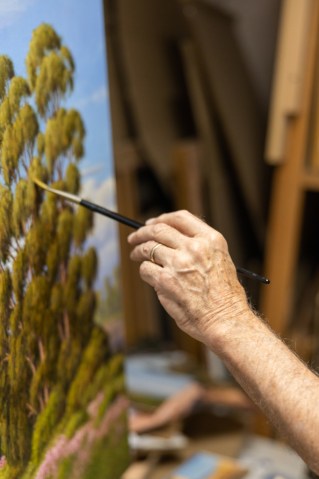
Though he originally focused on wildlife paintings, Ralph Waterhouse now paints landscapes almost exclusively. | Credit: Ingrid Bostrom
“We were living in a cottage on a farm,” Ralph says. The job that brought the young family to Scotland didn’t pan out, and after doing some freelancing, Ralph was offered a job at an advertising agency in Edinburgh, where he stayed for two and a half years, until his cousin Alan, now a partner at an advertising agency back in England, lured him to return. Ralph worked for the Colbert Advertising Agency in Doncaster for four years, and his second child, Scott, was born there.
While in Doncaster, Ralph started painting wildlife more seriously and started to earn an income from this work. At the same time, he began to get tired of working for an advertising agency where 45 percent or more of his hard work would end up being changed. On the weekends, Ralph and his young family would venture to the Lake District, primarily famous for its mountain, lake, and coastal scenery, and for its literary associations with Beatrix Potter and its arts community. They bought a caravan and made it their holiday home.
Around this time, his sister-in-law, who lived in California, fell ill with a kidney disease, and his wife wanted to be near her. So, in 1974, they sold their place in Doncaster and spent the next 10 months in Solvang.
“The weather conditions in California drew me out,” says Ralph. “I built a relationship with the Copenhagen Gallery, which was representing artists like Eyvind Earle. Being connected with this gallery was great. They took my work on consignment.”
Ralph and his wife intended to emigrate more permanently to the U.S., but it wasn’t meant to be. They returned to England, and eventually the marriage also didn’t work out. But his wildlife work continued to thrive.
Yet Ralph had become smitten by California and its natural beauty. He returned in 1981 after his divorce. He met Diane in February 1983 on a blind date. Diane’s father, Joe Makray, a portrait painter, had known Ralph’s ex-brother-in-law. When Ralph suggested taking Diane to Peabody’s on Coast Village Road, she insisted on going to Lucky’s for drinks. Afterward, they went to Pamela Auchincloss’s gallery near the Arlington. They followed this by dinner at the Wine Cask, where Diane boldly asked him if he wanted to meet her dad. They capped off the evening — which had so far consisted of four events — with a nightcap at the Biltmore.
The romance was on.

[Click to enlarge] “Sunset at Douglas Preserve” by Ralph Waterhouse
“I can’t move to England,” Diane told Ralph. So he stayed, and they got married. One day while they were walking their dog, a friend asked Ralph where he wanted to live in Santa Barbara, and he pointed to their current home adjacent to the Douglas Preserve. In a rapid succession of serendipitous circumstances, the newlyweds found themselves in escrow 24 hours later. Not surprisingly, their house is one of the most artistically stimulating places I’ve seen, with 170 paintings, including five portraits of their daughter Claire, who was born in 1995. Claire is a former student of mine at SBCC, a UCSB graduate, and now the Santa Barbara International Film Festival’s education manager.
“Being an artist and having a gallery gives Ralph a unique understanding, for he knows what it’s like for an artist to be shown in a gallery,” says Diane. “There’s a special care that he provides. The criteria for me is that I have to love it. I want to own it, and I want to hang it.”
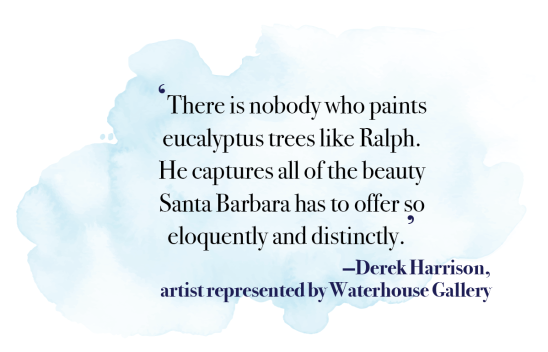
Ralph and Diane opened the first Waterhouse Gallery in November 1984 in Solvang, and they would commute daily from Santa Barbara. Their original sign now hangs at La Arcada. While the sign remains, they quickly understood that they had made a mistake in choosing to locate their venture in the Danish village. “It was a weekend business with no tourists during the week,” explains Diane. They found some good clients, but it wasn’t enough to sustain them. Ralph would travel twice a year to England to do shows of his wildlife paintings.
After their five-year lease was up in Solvang, they made another mistake. In 1989, they moved the gallery to Santa Barbara to a spot near the Arlington Theatre, right at the time when Paseo Nuevo had opened and moved the bulk of shoppers a few blocks down on State Street. “We were stuck up there, and it was rough,” Ralph remembers. They were offered the current space in La Arcada in 1991, where the foot traffic was much better. “A lot of locals would come in,” Ralph says. “Courthouse employees, bank employees, people dining at the Acapulco restaurant [with the iconic turtle fountain, where Pizza Mizza is now located].”

[Click to enlarge] “Butterfly Beach” by Ralph Waterhouse
In 1988 and 1989, Ralph shifted his artistic focus from wildlife to painting landscapes. “I was looking at my surroundings and decided to give it a go,” he declares. “The landscape work eclipsed the wildlife paintings in a year.” He enjoyed it more as well. The weather was better here than what he’d experienced in England, and he could paint outdoors. “The California landscape really gave me a boost,” he affirms.
Ralph built a studio above the downtown gallery. Most days, he gets in at 8:30 a.m. and is able to paint until noon, when he opens the gallery doors to clientele. I have to twist his arm to allow me to visit his upstairs studio — a veritable nest — with great lighting and views of La Arcada. He’s currently working on larger canvases he’d bought about 15 years ago for a commission from the former Santa Barbara Bank and Trust.
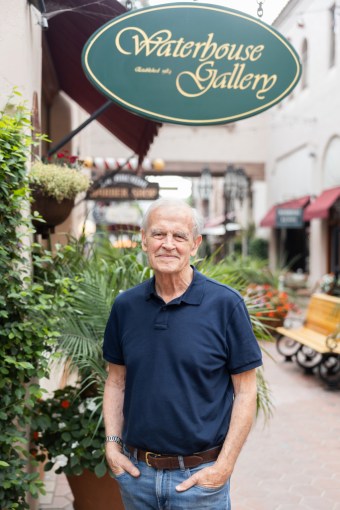
“If I have my way, I paint six days a week,” he says. “I work on several projects at a time. I paint two big pieces a month and six to 10 small pieces. The most consistent I’ve been was during COVID.”
But lately he was distracted by a remodel on their home, where he acted as the contractor and took close to a year to complete it. He also designed the new gallery on Coast Village Road. Without distractions, Ralph paints 35 hours a week. “I get into a zone and get carried away,” he tells me, chuckling.
On April 1 of this year, they opened the Montecito gallery next to Ca’Dario restaurant. It’s a bustling area. “We thought about Coast Village for a long time,” Ralph says. “It’s an affluent neighborhood, and a good place to do business.”
Diane runs their satellite extension and feels exhilarated by the response to the second location. “We have two different clienteles,” she explains. “There are more tourists downtown. It’s apples and oranges.”
Painter Harrison is effusive about being represented by the couple. “I am truly grateful for Ralph and Diane,” he says. “I owe them so much, more than I could ever repay. In addition to being a
second family, they act as agents, marketing
executives, and managers to my career. They have become the dream team of gallery owners.”
“Everything we do is related to art,” Diane says. It’s not an understatement. Five years ago, they started The Artist’s Table, a fundraiser with artists that benefits the Santa Barbara Museum of Natural History’s education programs. In different capacities, they’re involved with the Art Foundation, the California Art Club, the Santa Barbara Museum of Art, and the Santa Barbara Historical Museum, among others.
“He loves what he does,” Diane gushes about her husband. “He has a beautiful life. He’s painting; he brings artists together. He mentors young artists. He shares art with clients. It’s such a rich life.”
“I feel lucky and privileged,” Ralph tells me in his typical humble manner. “A lot of artists don’t make a living.”
He, in turn, has managed to make quite a wonderful life.
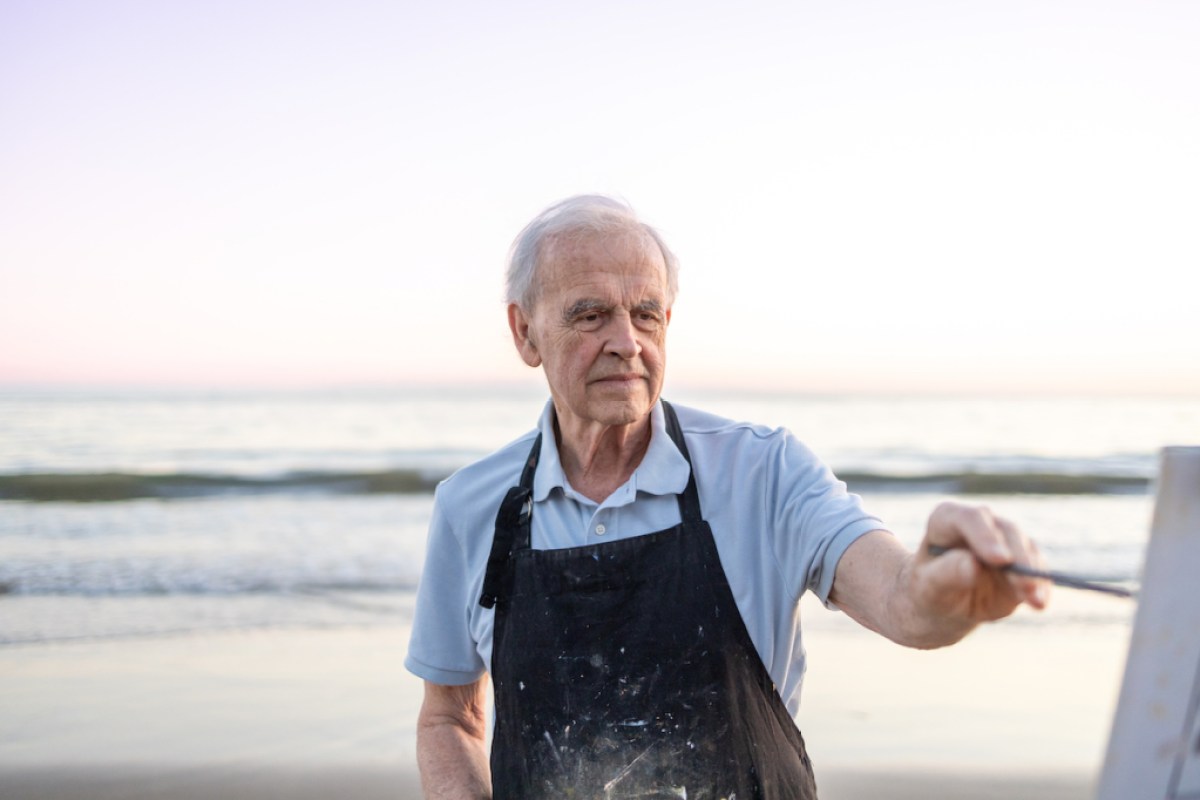




You must be logged in to post a comment.